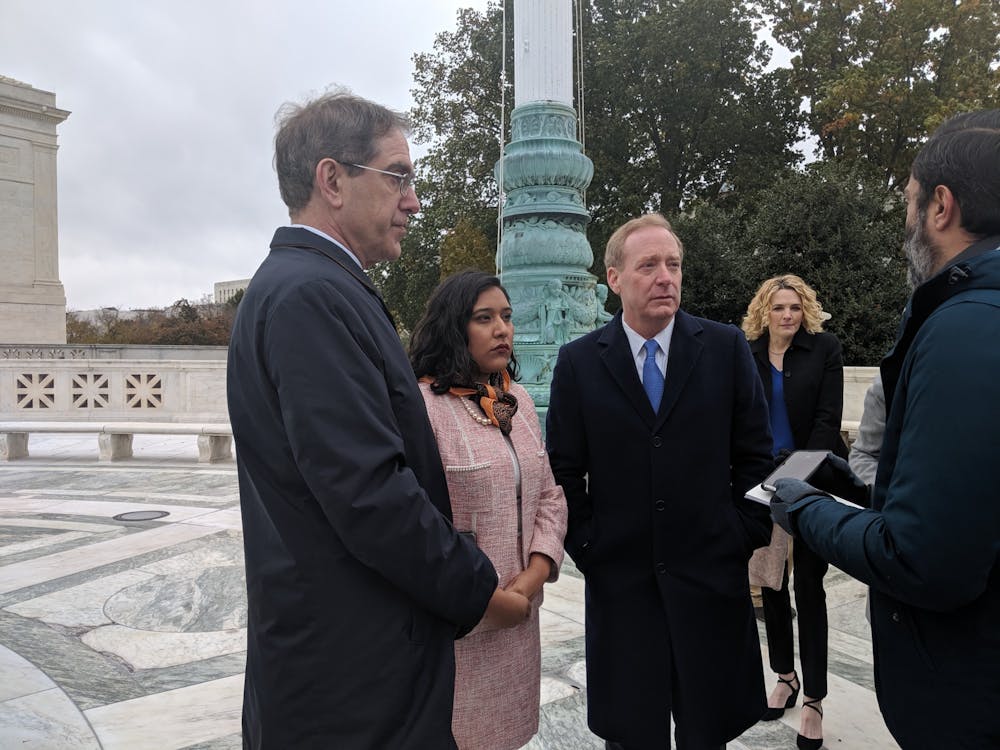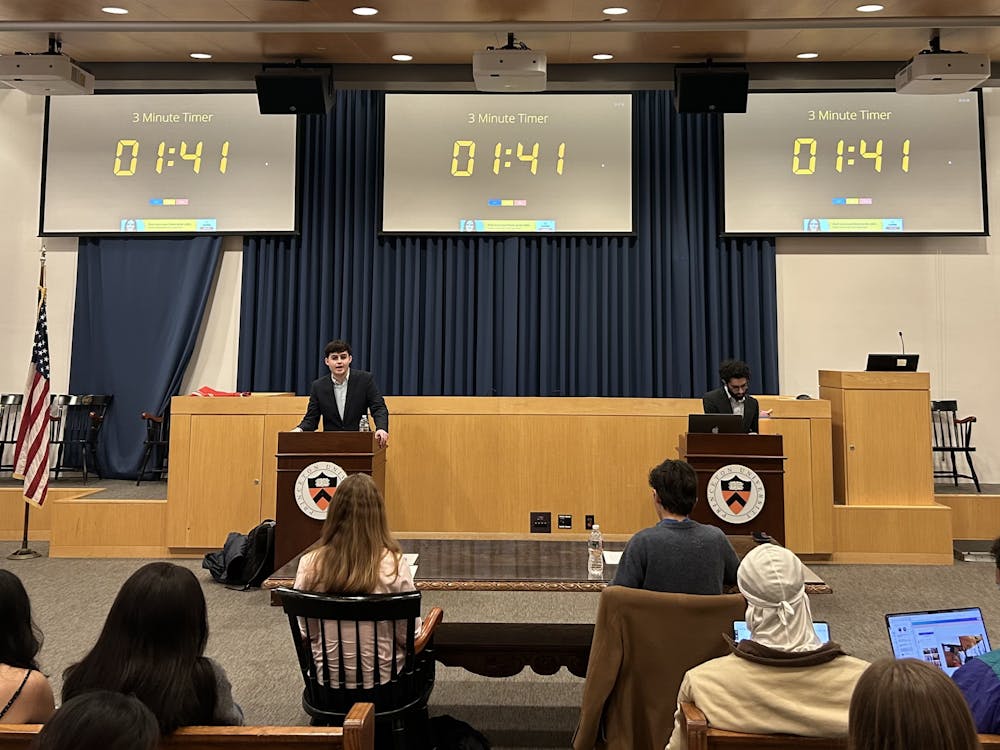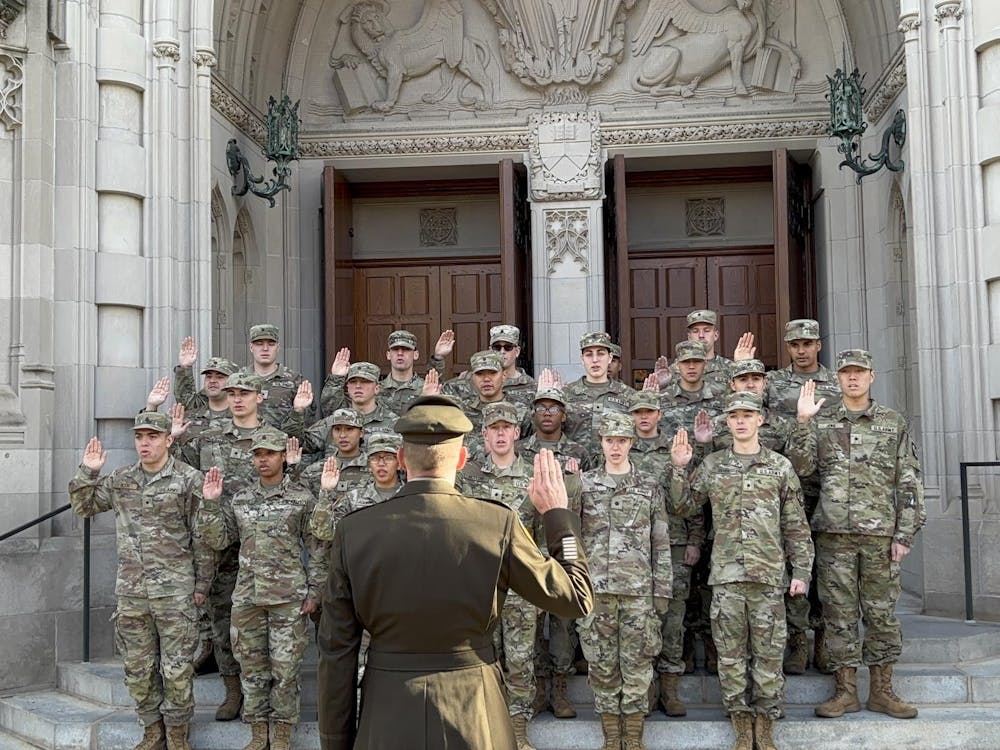On Tuesday, Nov. 12, the Supreme Court of the United States heard the oral arguments pertaining to suits on Deferred Action for Childhood Arrivals (DACA), including a complaint compiled by the partnership between the University, Microsoft President and University trustee Brad Smith ’81, and María Perales Sánchez ’18.
The November 2017 complaint, which was one of the first challenges to the government’s decision to end DACA, alleged that the program’s termination violated both the United States Constitution and federal law. In the two years that followed several district courts and courts of appeal have ruled that the government’s decision to rescind DACA was unlawful.
The oral arguments focused on two considerations: whether or not the rescission of the DACA policy is immune from judicial review, and whether the rescission of the DACA policy violated the Administrative Procedure Act (APA).
Solicitor General of the United States Noel J. Francisco argued on behalf of the petitioners, saying that the decision cannot be subject to judicial review and does not violate the APA because it was “eminently reasonable.”
Francisco consistently described DACA as a “stopgap measure” that “could be rescinded at any time” and one that former President Barack Obama never meant to last indefinitely in the first place.
Former United States Solicitor General Theodore B. Olson represented the private respondents, one of which was the University. He argued that the decision to rescind DACA came under the court’s “strong presumption of reviewability.”
Olson was Solicitor General under President George W. Bush, and is also a founding member of the Federalist Society, members of which helped create the short list of Supreme Court nominees for President Donald J. Trump.
Olson emphasized the number of people who would be affected by the rescission of DACA.
“The government's termination of DACA triggered abrupt, tangible, adverse consequences and substantial disruptions in the lives of 700,000 individuals, their families, employers, communities, and Armed Forces,” Olson said.
A number of the justices also expressed the importance of considering the number of people affected by the decision. Justice Sonia Sotomayor ’76 said, about the administration’s decision, “this is about our choice to destroy lives,” while Justice Stephen Breyer took a minute to list all the different briefs presented before the court.
“I counted briefs in this Court, as I'm sure you have, which state different kinds of reliance interests,” Breyer said. “There are 66 healthcare organizations. There are three labor unions. There are 210 educational associations. There are six military organizations. There are three home builders, five states plus those involved, 108, I think, municipalities and cities, 129 religious organizations, and 145 businesses.”
Justices Samuel Alito ’72 and Neil Gorsuch repeatedly questioned Olson on the topic of reviewability. Gorsuch repeatedly asked Olson what the “limiting principle” was that made the case different from the case of “Heckler v. Cheney,” in which the Supreme Court ruled that particular agency refusals were not subject to judicial review unless a statute stated otherwise.

When Olson quoted a line from the “Cheney” decision that an “action itself provides a focus for judicial review because it imposes the coercive power of the government with respect to individual liberty and property,” Gorsuch responded, “Doesn't every prosecutorial decision affect individual liberty or property?”
Olson quickly stated that every “prosecutorial” decision does, but DACA is different as “an announcement of policy."
When Justice John Roberts asked what was to stop a presidential administration from ceasing to enforce immigration completely, Francisco argued that that particular situation would fall under the exception in “Cheney” for “a complete abdication of authority.”
Justice Brett Kavanaugh asked Olson if he agreed that the executive has the authority to rescind DACA, to which he said yes, but contended that former Secretary of Homeland Security Kirstjen Nielsen’s explanation for their decision was entirely insufficient.
“Camp versus Pitts specifically says, when an explanation for an agency decision is given, however curt, they must stand or fall on that explanation,” Olson said.
A sizable portion of the oral argument was spent on whether or not the Trump administration’s allegation that the initial implementation of DACA was “illegal” was at all valid. Francisco repeatedly argued that whether or not DACA was illegal was of no real consequence because the administration had “several separate and independently verified reasons.”
California Solicitor General Michael J. Mongan, who represented the state respondents, argued that the Trump administration’s allegation of illegality was of consequence because it was, as Kavanaugh put it, “intertwined” with the administration’s other “policy” reasons for rescinding.
“I think it's important to look to the penultimate paragraph in that memorandum, where [former Secretary Nielsen] conducts her collective weighing and she considers those policy rationales along with the legal rationales and say that, together, they outweigh the purported costs of terminating DACA,” Mongan said.
On the topic of the “intertwined” nature of illegality and other reasons Neilsen gave, Justice Elena Kagan ’81 said “we really don't know how she would have conducted that balance, how she would have weighed those two [reasons], if the legal had been taken away from it.”
Justice Ruth Bader Ginsburg appeared to share Kagan’s concern, saying “we don't know how she would respond if there were a clear recognition that there was nothing illegal about DACA.”
“If we take that out, then the independent ground that you're asserting, then she would be saying we stand up and say this is the policy of our administration,” Ginsburg continued. “[She would be saying,] ‘We don't like DACA and we're taking responsibility for that,’ instead of trying to put the blame on the law.”
University President Christopher Eisgruber ’83, Brad Smith ’81, and Sanchez were all in attendance for the argument.
“I feel optimistic about our prospects in this case,” Eisgruber said. “I believe we have a very sound legal argument that is founded on the fundamental principle that when the government makes decisions that have implications for the rights of many people, it has a responsibility to state its reasons forthrightly and honestly, so it can be held accountable for what it does.”
President Donald J. Trump tweeted earlier Tuesday morning about the DACA cases.
“Many of the people in DACA, no longer very young, are far from ‘angels.’ Some are very tough, hardened criminals,” Trump wrote in a tweet. “President Obama said he had no legal right to sign order, but would anyway. If Supreme Court remedies with overturn, a deal will be made with Dems for them to stay!”
The CATO Institute noted that arrest rates for DACA recipients were below that of other U.S. residents, and Vox reported that committing “a felony or significant misdemeanor, or three misdemeanors of any kind” can lead to DACA disqualification. In Obama’s 2011 Rose Garden Speech, given the same day the DACA policy was announced, he did not say he lacked the right to act.
Eisgruber affirmed the importance of DACA individuals to the University community.
“DACA’s important to Princeton because the people who DACA benefits are important to Princeton,” Eisgruber said. “They make us a better place. They make other students better. They add to the experience in the classroom and they exemplify the values for which we stand.”
Eisgruber and Smith also reaffirmed their stance for DACA and those who benefit from DACA the day before in an op-ed for TIME.
“Microsoft and Princeton came together to support DACA because it is a wise and humane policy,” they wrote. “Leaders across higher education and business want a permanent solution for Dreamers because it is both an economic imperative and a humanitarian necessity.”








